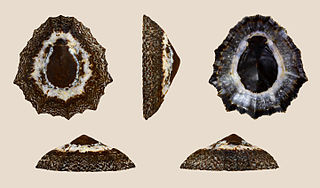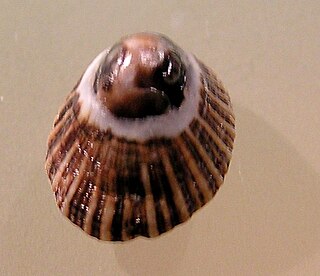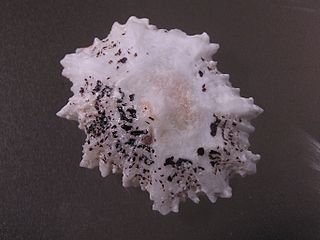
Gastropods, commonly known as slugs and snails, belong to a large taxonomic class of invertebrates within the phylum Mollusca called Gastropoda.

Archaeogastropoda was a taxonomic order of sea snails used in older classifications of gastropods, i.e. snails and slugs. Archeogastropoda are marine prosobranch gastropod mollusks, mainly herbivores, typically having two gills and a double-chambered heart, with the eggs and sperm discharged directly into the water. They were traditionally regarded as a relatively primitive group.

Limpets are a group of aquatic snails with a conical shell shape (patelliform) and a strong, muscular foot. This general category of conical shell is known as "patelliform" (dish-shaped). Existing within the class Gastropoda, limpets are a polyphyletic group.

The Patellogastropoda, common name true limpets and historically called the Docoglossa, are members of a major phylogenetic group of marine gastropods, treated by experts either as a clade or as a taxonomic order.

Fissurellidae, common name the keyhole limpets and slit limpets, is a taxonomic family of small to medium-sized limpet-like sea snails, marine gastropod molluscs in the clade Vetigastropoda.

Patellidae is a taxonomic family of true limpets, marine gastropod molluscs in the superfamily Patelloidea. (The superfamily Patelloidea should not be confused with the similar-sounding genus of true limpets Patelloida which is in the family Lottiidae within the superfamily Lottioidea, also part of the Patellogastropoda.)

Lottiidae is a family of sea snails, specifically true limpets, marine gastropod mollusks in the superfamily Lottioidea and the clade Patellogastropoda.

Neolepetopsidae is a family of small deep sea sea snails or true limpets, marine gastropod mollusks in the subclass Patellogastropoda.

Patella vulgata, common name the common limpet or common European limpet is a species of sea snail. It is a typical true limpet; a marine gastropod mollusc in the family Patellidae, with gills. This species occurs in the waters of Western Europe.

Cymbula granatina, the granite limpet, is a species of sea snail, a true limpet, a marine gastropod mollusc in the family Patellidae, one of the families of true limpets. Unlike some other species of giant limpet, C. granatina is non-territorial, and feeds on a variety of different algae.

Helcion concolor, common name the variable limpet, is a species of sea snail, a true limpet, a marine gastropod mollusk in the family Patellidae, one of the families of true limpets.

Patella lugubris is a species of sea snail, a true limpet, a marine gastropod mollusk in the family Patellidae, one of the families of true limpets.
Scutellastra natalensis is a species of sea snail, a true limpet, a marine gastropod mollusk in the family Patellidae, one of the families of true limpets.

Scutellastra aphanes is a species of sea snail, a true limpet, a marine gastropod mollusk in the family Patellidae, one of the families of true limpets. It is endemic to South Africa.

Scutellastra argenvillei or Argenville's limpet, is a species of sea snail, a true limpet, a marine gastropod mollusk in the family Patellidae, one of the families of true limpets.

Scutellastra flexuosa is a species of sea snail, a true limpet, a marine gastropod mollusc in the family Patellidae, one of the families of true limpets.

Scutellastra kermadecensis is a species of true limpet, a marine gastropod mollusk in the family Patellidae. It is endemic to the Kermadec Islands.

Cymbula is a genus of sea snails, the true limpets, marine gastropod mollusks in the family Patellidae.

The subfamily Emarginulinae, common name keyhole limpets and slit limpets, is a taxonomic subfamily of limpet-like sea snails, marine gastropod molluscs in the family Fissurellidae, the keyhole limpets and slit limpets.
Cymbula sanguinans, the giant pinkray limpet, is a species of giant limpet, a marine mollusc in the family Patellidae. It is native to the coast of South Africa. At one time thought to be a subspecies of Cymbula miniata, molecular analysis has shown C. sanguinans warrants being treated as a full species, despite there being no obvious morphological differences between the two. This makes difficult the task of deciding which of the previous research studies refer to C. sanguinans, and which refer to C. miniata.
















